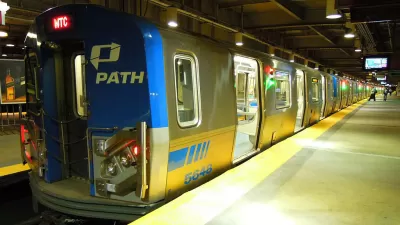One of the many glorious perks of being an engineer is that we are so bad at thinking up clever names for programs and tools that there's been an unabashed, universal concession by the general public to accept our use of horribly convoluted acronyms. My favorite transportation acronym sub-genre is the collection of traffic signal configurations that for no clear reason (other than because engineers are, deep down, fun people) have flown off on a winged tangent. The original intersection signal control which included pedestrian push buttons was “PEdestrian LIght CONtrolled”, close enough to be named “Pelican”. A “Pedestrian User-Friendly INtelligent crossing” alternative to the Pelican is named “Puffin”. Since a combined pedestrian/bicycle signal means two (
One of the many glorious perks of being an engineer is that we are so bad at thinking up clever names for programs and tools that there's been an unabashed, universal concession by the general public to accept our use of horribly convoluted acronyms. My favorite transportation acronym sub-genre is the collection of traffic signal configurations that for no clear reason (other than because engineers are, deep down, fun people) have flown off on a winged tangent. The original intersection signal control which included pedestrian push buttons was "PEdestrian LIght CONtrolled", close enough to be named "Pelican". A "Pedestrian User-Friendly INtelligent crossing" alternative to the Pelican is named "Puffin". Since a combined pedestrian/bicycle signal means two (modes) can cross simultaneously, the "Toucan" is the most recent addition to the intersection control aviary. A joke (amongst engineers, mind you) in the office is what bird-brained signal control names will we be forced to endure next: Cockatoo, Ostrich, Rock Cornish Hen? Although congress claims copyright for recent transportation bill acronyms - Intermodal Surface Transportation Efficiency Act (ISTEA, pronounced "Ice Tea") and Safe, Accountable, Flexible, Efficient Transportation Equity Act: A Legacy for Users (SAFETEA-LU), I suspect there was consultation with engineers to get these just right. I'm hoping the new transport bill to be proposed this summer might be something cool like "Inclusion of Localized Intermodalism for a Kinder Environment: Pedestrians, Bicyclists, & Jitneys While Maintaining Infrastructure Longevity and trucKing Act" (I LIKE PB&J W/MILK).
To that end, I'd like to propose a new term to describe important work crucial to the advancement of transportation policy while simultaneously promulgating a wonderful new acronym in honor of my profession's legacy: Convergence of Mobility and Mobility (ConMaM). It's not a typo. The technology and transportation industries use the same word "mobility" for two very different purposes. In technology, mobility represents the ease of portability of various devices (phones, cameras, music players, etc.). In transportation, mobility describes the ease of portability of ourselves. The idea of ConMaM is that the more we take advantage of the power of mobile devices, the better we will be able to get around. That is, as we converge mobile devices with mobility systems, we will be able to improve the efficiency and convenience of these systems.
An example I often use is to consider yourself enjoying time with friends and bumping up against the time when you need to leave. The problem is that you know your train/bus/ferry suffers from Incoherent Scheduling Syndrome (yes, ISS*), and an unimaginable array of possible delays could further complicate an accurate transit rendezvous, potentially leaving you loitering uselessly on a platform when you could be savoring those last moments with friends. In my fantasy world of mobility convergence, this dilemma could be solved by a simple 5-digit text message to query the next 5 arrivals of your ride based on the current schedule status. The arrival times are returned to your phone, allowing you to decide on the fly when you will leave. Some might feel these are incremental gains at an individual level, but if one considers all the times one finds himself wondering how soon the next tram will arrive, missing a 30 minute headway bus by 30 seconds, or waiting twenty minutes due to a track delay, then perhaps such time saving solutions may not seem so petty. Said another way, these are the tiny missing aspects of convenience that cause many people to choose a car over transit.
Of course much effort is already being made towards mobility convergence. I appreciate the text message alerts I receive from PATH when a train is delayed for "police investigations" or "track conditions". Princeton University's TigerTransit system brilliantly (really, check this out!) apprises riders of the exact location of its fixed-route shuttle bus via web-accessible cell phone. But mobility convergence can go much further: querying your nearest bike-share racks via cell to find out which one has bikes available (and reserving it with a maximum five minutes count-down), comparing the current run-times for bus and subway between two points to choose the quickest mode, prepaying for BRT or ferry fare via cell while you rush to make a transfer instead of queuing when you get there. Even getting a traffic update on a saved route to possibly deter you from driving. ConMaM is the answer to these and many more incremental efficiencies that will make transit options more convenient and attractive. And when ConMaM is commonplace, rest assured we engineers will have devised countless other acronyms to spice up your conversation.
* A little ditty on Incoherent Scheduling Syndrome (ISS): While I'm on an acronymnal roll, I thought I would interpose another term to describe the entirely logical, but impossibly incoherent schedules offered by transit agencies. Transit schedules should be overlaid with a more intuitive method of access that allows riders to forget that, for example, weekdays between 4:32 PM and 6:40 PM the train departs every six minutes, and then every ten minutes until 9:22 PM. Transit operators should tap into mobility convergence for the solution, just as most people enter a contact's phone number to their cell phone and then forget it for a more intuitive method of access (a contact's name). The propensity of transit agencies to use such schedules is endemic, and nearly impossible to remember, never mind intuitive; hence, Incoherent Scheduling Syndrome.

Planetizen Federal Action Tracker
A weekly monitor of how Trump’s orders and actions are impacting planners and planning in America.

Restaurant Patios Were a Pandemic Win — Why Were They so Hard to Keep?
Social distancing requirements and changes in travel patterns prompted cities to pilot new uses for street and sidewalk space. Then it got complicated.

Map: Where Senate Republicans Want to Sell Your Public Lands
For public land advocates, the Senate Republicans’ proposal to sell millions of acres of public land in the West is “the biggest fight of their careers.”

Maui's Vacation Rental Debate Turns Ugly
Verbal attacks, misinformation campaigns and fistfights plague a high-stakes debate to convert thousands of vacation rentals into long-term housing.

San Francisco Suspends Traffic Calming Amidst Record Deaths
Citing “a challenging fiscal landscape,” the city will cease the program on the heels of 42 traffic deaths, including 24 pedestrians.

California Homeless Arrests, Citations Spike After Ruling
An investigation reveals that anti-homeless actions increased up to 500% after Grants Pass v. Johnson — even in cities claiming no policy change.
Urban Design for Planners 1: Software Tools
This six-course series explores essential urban design concepts using open source software and equips planners with the tools they need to participate fully in the urban design process.
Planning for Universal Design
Learn the tools for implementing Universal Design in planning regulations.
Heyer Gruel & Associates PA
JM Goldson LLC
Custer County Colorado
City of Camden Redevelopment Agency
City of Astoria
Transportation Research & Education Center (TREC) at Portland State University
Camden Redevelopment Agency
City of Claremont
Municipality of Princeton (NJ)




























